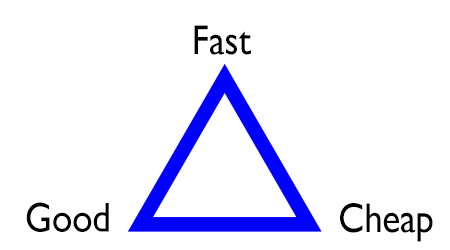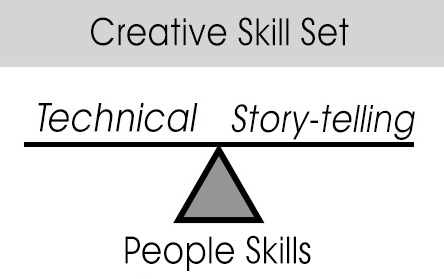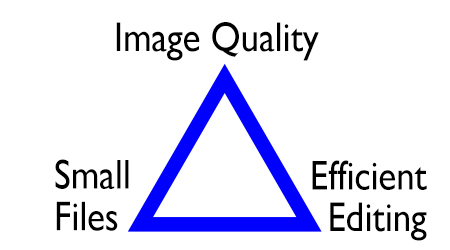
I’ve discovered, in working in the media industry, that there are a number of relationships that impact the work we do and results we create. Two of these are triangles, the third is a balance-beam.
I first wrote this in October, 2017, but, as I’ve been teaching over the past year, I realized that there’s more to add.
THE CREATIVE CHALLENGE
Let’s start with the most famous. I certainly did not invent this, but it is undeniably true.

Creativity may be unlimited, but creative choices are not. This classic triangle illustrates that any creative choice has three boundaries:
The problem is that we can only pick two.
I find this relationship to be invaluable in setting expectations in clients – and myself. I also find this reassuring as I plan a new project, because it forces me to rethink my planning by asking this question:
Notice that I didn’t ask: “With the quality I expect.” But, rather: “With the quality the client expects.” Exceeding the expectations of the client is a great way to get more work. Working to exceed our expectations is a great way to miss the deadline and blow the budget.
For me personally, everything I do is deadline-driven. So I am continually asking myself: “What do I need in order to get this done on time?” If I were to do a project where quality is most important, I’d make sure that I didn’t assign myself a deadline.
CREATIVE SKILLS

Norman Hollyn is responsible for me thinking about this. As we were creating 2ReelGuys.com, we would get into long discussions about whether story-telling or technology was more important to an editor. Norman always came down on the side of story-telling, while I felt technology was more important.
NOTE: In teaching students, I’ve come to realize they are obsessed with technology; and not sensitive enough to the stories they tell. So, in my classes today I make a much bigger point of thinking about the story you want to tell.
However, as I became more involved in hiring people for creative teams, I realized that the story vs. tech balance was insufficient. Which lead me to create this illustration.
What this image says is that story-telling and technical skills are equally important, but both rest on a foundation of people skills. If no one wants to work with you, all the story and tech skills in the world won’t get you a job.
I believe that any creative task is:
It is easy to become obsessed by our story or the need for better technology. But no creative task lives in a vacuum. Creativity is collaborative and our ability to work with others is essential to completing any creative task. From funding through production to distribution, we are always working with others.
We need to make sure we are worth working with.
SIDE-LIGHT
I also have very limited patience with editors who say: “I can’t be bothered by all this technology, I tell stories.” This is simply arrogance. A great story-teller with no technical skills has no ability to express their story. Instead, they must rely on assistants to make sure their gear is working, video formats are converted, final output meets all technical specs…. in other words, that editor is crippled in their ability to complete a project because they don’t have sufficient technical skills.
Specialists are always needed in today’s society, but as I build teams, hiring a creative specialist means that I also need to hire someone else to fill in their missing skills. This is fine when budgets are large, but, well, budgets aren’t so large these days and a lack of skills means that others who have a more well-rounded skill set are more likely to get the gig. (In other words, a lack of skills often costs an editor money.)
THE TECHNICAL SIDE
As we convert analog light and sound into binary one’s and zero’s, we discover that everything we do is dependent upon a “codec.” Short for compressor/decompressor, this mathematical algorithm converts light and sound into binary, then converts it back so we can view that media file later.

However, no codec does everything. Codecs are optimized for specific tasks and, like all good triangles, we can only pick two:
I find this relationship to be helpful in explaining to clients and students that there is no free lunch. The more you think about your technology up-front, before you start production, the more likely you are to get the results you need, on time and on budget, during the life of the project.
SUMMARY
Creativity is all about trade-offs, but that isn’t always bad. I think we do our best creative work when pushing against barriers. Barriers of time, or resources, or skills. I’ve often felt that the best thing you can say to a creative person is: “You can’t do that…”
Darned if we don’t somehow find a way.